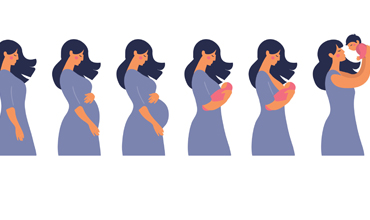You’ve received a positive pregnancy test, and it’s time to prepare for the new baby’s arrival. Expecting a baby is an incredibly exciting time. Over the next nine months you will arrange the nursery, buy a car seat, pick out baby clothes and purchase baby gear and gadgets. But the most important way you will prepare for your baby is through excellent prenatal care. You may be wondering what to expect at your doctor’s appointments and what the timeline looks like. While every pregnancy is different and there are always exceptions, here is a quick breakdown of what Mayo Clinic says you can expect for the obstetric timeline of an average pregnancy.
Your first appointment (6-10 weeks)
After you receive a positive pregnancy test, contact your doctor to schedule your first visit. They will typically see you between six and ten weeks gestation. You can expect to go over your health history, risk factors and discuss any diet and lifestyle changes needed during pregnancy. Your doctor will also ask for a list of your current medications and may make adjustments. Be sure to include information on your mental and emotional history. They will also check your weight, blood pressure and take a urine sample. The doctor will calculate your due date and go over the schedule of future prenatal appointments. They may do an early ultrasound to check on the baby’s development, do a pelvic exam with or without a pap smear and order blood work to screen for medical conditions and check hemoglobin. This is a great time to address your questions and concerns regarding pregnancy, delivery and your health as well as the baby’s.
First trimester appointments
(10-14 weeks)
After your initial visit, the appointments should become shorter in length, and you can expect to visit your doctor about every four weeks unless your pregnancy is determined to be at higher risk. At your second appointment the doctor should be able to hear the baby’s heartbeat via doppler (usually around 8-10 weeks). Each visit your doctor will check your weight, blood pressure and take a urine sample. You will have an opportunity to ask questions and voice any concerns.
Second trimester appointments
(14-26 weeks)
During the second trimester, women often experience less nausea, more energy and begin to feel more comfortable with their changing bodies. You will continue to visit the doctor every four weeks during this time and can expect a similar experience as previous visits. Your doctor will continue to check your vitals each visit, monitor fetal growth and movement and track fetal growth. During the second trimester you will have the opportunity for additional testing including blood work, fetal testing and the option to test for genetic abnormalities. You may also have an anatomy scan done via ultrasound to check on the development of your baby’s vital organs, and you will be given the opportunity to find out the sex of your new baby. Your doctor will also begin to discuss delivery expectations and create a birth plan. This is also a great time to take birthing classes, tour the birthing center and take care of the pre-registration paperwork.
Third trimester appointments
(26-40 weeks)
During the last trimester you can expect to visit the doctor more often. The typical schedule is every two to four weeks for 24 to 36 weeks gestation and every week from 36 weeks gestation until delivery. In addition to tracking your weight, blood pressure, and fetal development and growth, your doctor will also ask you if you are experiencing any labor symptoms and will let you know what to look for as delivery approaches. You will likely be checked for B Strep, gestational diabetes and the baby’s position will be monitored before delivery. You can expect to have pelvic exams to check for signs of labor in the later part of your third trimester. This is a great time to pack your hospital bag and get last minute preparations in order before the baby’s arrival.
Every pregnancy is different, and many factors will determine the timeline your doctor will set for prenatal visits. Check with your doctor and follow their guidelines for the best care for you and your baby.
Tips for finding the right OB/GYN
- Check your insurance – as you begin your search, find providers that are in your insurance network.
- Ask friends and relatives for recommendations. This can be a great place to start when you are looking for a new doctor.
- Do you have a preference when it comes to your doctor’s gender?
- Location is important when choosing a doctor.
- Research the hospital or birthing center where you would like to deliver your baby and confirm that the doctor you are choosing delivers there.
- Decide if you will have a doctor, a midwife, or both.
- If you have specific preferences with your birth plan, confirm that the doctor will accommodate your wishes.
- Are you high risk? If yes, find out if there is a doctor that specializes in high-risk pregnancy.
- Set up a consultation appointment and ask questions, do you feel you are compatible with the doctor?
- Is it a large practice? How likely is it that your doctor will deliver the baby? This is always a good question to ask so you know what to expect when labor begins.
Sarah Lyons is a busy mom of six kids, including triplets. She enjoys reading, writing, cooking and spending time outside with her family.














